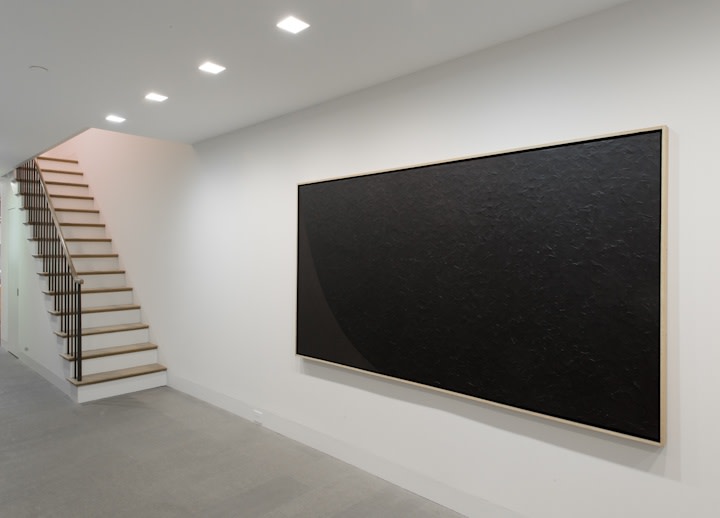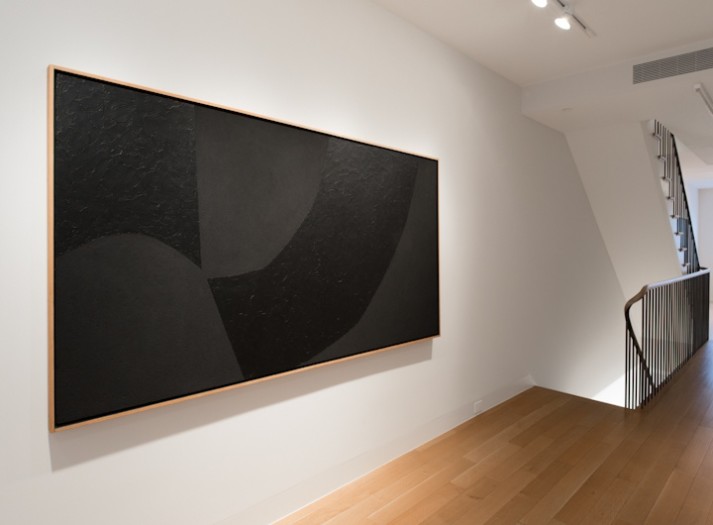Luxembourg & Dayan will present Alberto Burri: Black Cellotex, an exhibition of rare late works by a profoundly influential but often overlooked 20th century Italian master. Comprising a series of paintings made in the years between 1986 and 1987, the show unveils paintings never before exhibited in the United States and suggests the less explored connections between Burri, a consummate innovator and abstractionist, and the masters whose achievements in earlier centuries continue to exert a profound influence upon art. Reaching beyond painting’s conventional limits to give art a brave new repertoire, Burri was against image, interpretation, and all things except the rectilinear shape of a painting. Such fierce lyricism and technical focus position him upon the long continuum of artistic innovation and breakthrough.
On view through April 30th, Alberto Burri: Black Cellotex was organized with the support of the Fondazione Burri in the artist’s hometown of Città di Castello, Italy. Elegant and beautiful to 21st century eyes, the art of Alberto Burri (1915-1995) was nevertheless born of intense subversiveness and an ethos shaped by the terrifying whirl of creation, passion, anguish and destruction of World War II. A key early figure of the Arte Povera movement, Burri was a former military physician and prisoner of war who, along with fellow postwar artists, was intent upon burying age-old traditions of Western art. Having absorbed the traumas of war, he chose to experiment with materials endemic to reconstruction in its aftermath. In the early 1950s, Burri began using Cellotex, an industrial particleboard made of compressed sawdust and glue, as the base for his paintings. Engaged in an investigation of the modern world and its new materials, his Cellotex paintings were concerned above all with carapace -- with creating and breaking the surfaces of a plane, denying traditions of precious materials, and destroying the viewer’s intellectual associations in order to replace them with pure sensation.
And yet Alberto Burri’s work is remarkably classical: Compositionally his paintings follow in the footsteps of the early Sienese, Florentine and Venitian masters working in the areas fanning out beyond the artist’s birth region of Perugia. And Burri’s ability to articulate formal balance vividly recalls Duccio, Giotto and Titian. Nowhere is this sense of painterly composition more acute than in his last works in black Cellotex. In 1975, after 25 years of using the material exclusively as an invisible supporting ground for his paintings, Burri stripped his exploration down to its barest minimum. He made Cellotex both his material and his subject, visible as the raw surface and primary field of focus. With exposed Cellotex, Burri examined how one might achieve compositional balance without the assistance or intervention of any additional medium. Thus his cycle of Black Cellotex paintings from the 1980s removed the final “crutch of color” and revealed Burri’s work at its most dramatic and bare way.
Using knives and various hand-made instruments, he sculpted the surface of Cellotex board by cutting, shaping, scratching, pulling, and marking to create textured black-on-black forms that reference the full scope of classical subject matter, from the body to perspectival representation. Burri’s native adventurousness in both material and form, along with his attraction to experimentation, stand in direct opposition to his classical formalist approach, and it is precisely this conflation of the conventional with the unexplored that resonates in the
exhibition Alberto Burri: Black Cellotex.





